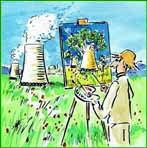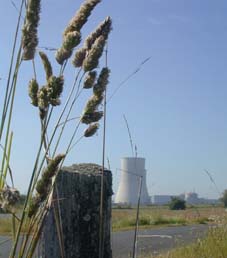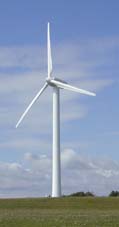|

|
EFN -
NEWS
Newsletter of the
Association EFN
12 December
2003
|
French White Book on Energy
- Summary and comments
This document is archived on
the internet and can be consulted at the following address:
http://www.ecolo.org/archives/archives-nuc-en/
by Michel LUNG, Deputy Secretary of EFN
Submitted to the magazine "Nuclear
Engineering International"
The Deputy Minister for Industry Nicole Fontaine, former President
of the European Parliament, organized a Public Debate on Energy from
January to May 2003, to respond particularly to claims of the Green
fraction of the public that energy matters in France, especially
those related to nuclear energy, were not transparent . The seven
sessions were held in Paris (2), Strasbourg, Nice, Bordeaux, and
Rennes (2) in presence of the Minister and were surrounded by many
contributions from all sorts of groups registered beforehand with the
Ministry, such as round tables, lectures, exhibitions, and
projections, all open to the public. Unfortunately the newsmedia did
not report much of these debates. The Greens themselves declined to
participate claiming that the debate was biased in favour of nuclear
energy.The debates were monitored by a small group of independent
energy experts and a Member of Parliament, helped in this task by the
DGEMP, Direction Générale de l'Energie et des
Matières Premières, a top-level group of young
specialists, many of them graduates of the elite Ecole Polytechnique.
Its role in the Ministry of Industry is to follow the trends of
energy and raw materials and to make predictions and recommendations
to the Government in a country largely devoid of energy resources.
Hence this White Book issued on 7 November by Nicole Fontaine for the
Government and for the public at large. It contains proposals for an
Orientation Law on energy strategies for France for the next thirty
years, which is to be discussed by the Parliament next year.
The White Book is a rather remarkable 120-page document. Every
statement is duly supported by facts and figures and a broad range of
statistics for France, and sometimes by comparisons within Europe and
the World in order to set them in context. This reflects the
professionalism of DGEMP and their broad database. The text can be
obtained on the internet site http://www.energie.gouv.fr.
The contents of the Book are presented in four sections:
1- The energy situation in France, the challenges and the place of
energy in the economic and social context. Demand and Supply sides
are analyzed by sector.
2- Proposed objectives leading to a sustainable energy policy.
3- Government proposals.
4- Supporting documents. This part is itself divided into two sets
of documents : principal existing and proposed rules and decrees,
intended to promote the rational use of energy, efficiency, energy
independence, etc. statistics, including energy trends for France
based on a reasonable reference scenario, as well as regional and
world trends.
We shall not enter into the details of the White Book but rather
give the highlights and the main proposals, and conclude with a few
personal remarks.
FIRST PART : SITUATION AND
CHALLENGES. Demand and Supply.
Demand is analyzed by sector in the usual way: residential,
tertiary, transport, and industry.The energy demand for the
residential sector grows by about 0.8 % per year in spite of some
efforts towards efficiency; this is due to the trend towards
increased comfort and increased use of electricity, mainly in heating
and air conditioning.The demand of the tertiary sector has grown 43 %
since 1986 - at an average annual rate of about 2.3% - mainly for
electricity. But the total consumption in the sector is still only
about half of that for the residential sector.Transport has grown
steadily since the sixties in spite of the oil shocks, exactly
following the Gross National Product; the sector is up 400 % since
1970, with 97 % provided by oil. Air transport today accounts for 4%
of the CO2 emissions. The upward trend in energy demand for
transports is the main concern today.Industry is the star performer -
since 1973 industrial energy demand is down 20 %, mainly due to a
decrease of 50 % in average energy intensity.Overall, the energy
demand in France increases every year by 29 Mtoe (million tonnes of
oil equivalent): oil for transportation is up by 2.3 % per year and
electricity is up by 2 %.
Supply has followed demand so far in France, largely thanks to
nuclear energy which supplies more than 80 % of its electricity. Here
are some considerations of the White Book: On the challenge posed by
the increase in greenhouse gas emissions and air pollution.Between
1990 and 2001, the CO2 emissions have decreased 2.7 % overall.
Although the CO2 produced by the transport sector is up 22 % and the
residential and tertiary sectors are each up 14 %, industry is down
by 18 %, agriculture down 4 %, energy production (mainly electricity)
is down 28 % and waste treatment is down 14 %. On the challenge posed
by the depletion and exhaustion of fossil reserves, and the tensions
which may arise from these trends.At the present rate of consumption,
these are estimated at 50 years for oil, 65 years for gas, and 260
years for coal. While the world demand will steadily increase, the
known reserves and the discovery of new reserves of fossil fuel will
diminish.The uranium reserves are limited too, but much remains to be
discovered, and techniques are under development to extend the
efficiency of nuclear energy towards a much better utilization of the
raw material. Renewable energies: Wood burning meets about 4.5 % of
the need for thermal energy. The European Commission has asked France
to produce 21 % of its electrical energy by renewables by 2010.
Today, about 15 % is provided by hydropower and only 1 % by other
renewable sources. The overall renewable production in the EU is 17
%. However, some large numbers given by Germany and Spain due to
their massive installation of wind power should be reconsidered
because only 2200 hours a year are available for wind production,
compared to 8000 hours for biomass, for example.France expects to
meet the European requests by some energy savings, some biomass
burning, some geothermal installations, some solar heating and 2000
to 6000 MW of wind energy, inland and seashore. (But there is growing
opposition to installing wind turbines on sites of interest to
tourism and agriculture.) Nuclear energy: It provided 80 % of
France's electricity in 2002 (437 TWh), with increased energy
independence, without CO2 emissions, and at competitive prices which
include the treatment of nuclear waste and provision for dismantling.
Nuclear waste is well managed and does not pose health problems. What
place for nuclear energy tomorrow? Nuclear energy will remain a major
component of energy production. Despite the probable extension of the
life of France's 58 nuclear units from 30 to 40 years (their average
age is now 19 years), it would be prudent to initiate a smooth
replacement of the existing units and not wait until Generation 4 is
industrially operable. Hence it is proposed to build an EPR as a
demonstrator to be put in operation by 2010, followed by other units
from 2020.
The uncertainties about the future costs of oil and gas have to be
included in this strategy.
SECOND PART : TOWARDS A SUSTAINABLE
ENERGY POLICY.
This part is treated in a rather synthetic manner and we shall
make few comments, as the opinions expressed are, as stated, rather
well accepted. Four priorities must determine the policies :- to
guarantee access at a reasonable price to all citizens everywhere in
the country,- to contribute to the economic competitivity of the
country,- to protect and conserve the environment,- to assure safe
energy supplies. The energy policy for the next decades will have to
face two major challenges :- to mitigate the effect of the greenhouse
gases on climate changes,- to mitigate the effect of possible
limitations on availability of oil and expected price increases. Thus
three major policy lines have to be followed :- to to launch a
genuine policy of energy savings, especially in the transportation
sector;- to diversify energy sources, insisting upon renewable
energies, i.e. that electricity reach the European Community goal of
21 % renewable by 2010; and for thermal energies a 50% increase in
the use of renewables by 2015, mainly with biomass, solar thermal and
geothermal, all of which offer largely untapped opportunities.
Concrete (and) operational measures must be taken to enforce these
policies :- education, training and information of the public,-
regulations, - tax incentives,- architecture regulations, -
certificates of CO2 limitations and emission permits,- examples to be
set by public organizations,- more research effort on ways to reduce
CO2 emissions and to increase efficiency, including cleaner and more
energy-efficient vehicles, to
reduce the cost of renewables, to develop the hydrogen economy,
CO2
sequestration, nuclear waste reduction, etc.
THIRD PART: GOVERNMENT
PROPOSALS.
The Government will propose an Orientation Law on Energy following
these
guidelines:
The Preamble will recall the necessity of mitigating the
greenhouse effect,
Title 1 relates to the control of energy demand, by diverse
means,
Title 2 relates to the need for social and territorial solidarity,
i.e. energy at acceptable prices and with reasonable access
everywhere in the country,Title 3 relates to reliability of energy
resources including electrical energy exchange with neighbouring
countries; this deals with nuclear energy and the distribution
network, but also with supplies of gas and oil, and price
stability.Title 4 deals with the need to develop renewable energies,
one of the principal conclusions of the National Debate. For
electricity, the aim should be 21 % renewable by 2010 and the same
for 2015; for thermal energies, the goal should be a 50 % increase
above the present renewable thermal sources by 2015.There follow
three Titles referring to special cases and territories (Corsica,
etc.).
The third part concludes with a draft of the Orientation Law along
these guidelines.
FOURTH PART: EXPLANATORY
DOCUMENTS
including comparisons with other Member States.AMENDMENTS proposed
to some existing laws and directives to make them conform to the new
Orientation Law,COMMENTS on the role of some Government agencies,
such as the Agency for Regulation of the Electricity Grid, etc.
STATISTICAL DATA in support of the White Book (tables and
graphs).We shall not enter into the detail of these explanations and
data for it would lead us into too much detail.
We shall, however, make an exception for the projections of energy
consumption in France for 2010 and 2020 according to a trends
scenario created by DGEMP. This scenario is an extrapolation of an
international project, prepared in 1999 for the International Energy
Agency, extrapolating the trends of 2000 assuming that no new
policies are introduced which might interfere with the
extrapolations, such as a serious attempt to cut back CO2 emissions.
Reality will be different, of course, and it will depend somewhat on
the options chosen; but it will not be greatly different, because
energy trends have a very long lead time and because it takes years
to modify the trends.
For example, the trends scenario shows a 33 % increase in energy
consumption (mainly for transport) for 2020 and a 20 % increase in
primary energy over the present situation. And if nothing were done,
CO2 emissions would be 40 % greater in 2020, after remaining stable
in the years 1990-1997; this is due especially to the explosion of
the transport sector in recent years.
My personal comments are that the White Book is a good document
and a good base for an energy policy. The proposed installation by
2010 of a relatively large number of wind turbines is offered to the
environmentalists as a trade-off for the nuclear option. Wind
turbines are not needed in France and their contribution will be
minimal, but the cost will be borne by the taxpayer. Some
environmentalists are beginning to see that these toys may be a
nuisance and of very little benefit to society, at least in this
developed country. On the other hand, pollution due to the
transportation sector should be addressed more energetically; hybrid
vehicles, electric vehicles for town use, and the transport of trucks
aboard freight trains are already feasible, and they must be
developed quickly. Let us hope that this political side of the report
can be met with common sense at the Parliament discussions.
 Michel
Lung, Deputy Secretary of EFN. Click
here to write to Michel
Michel
Lung, Deputy Secretary of EFN. Click
here to write to Michel
______________________________


http://www.ecolo.org
EFN - For complete and
straightforward information on energy and the
environment
To subscribe (or unsubscribe) to EFN's mailing list, go to EFN's
web site : http://www.ecolo.org
and click on "mailing list".
You may, with their approval, freely subscribe to the mailing list
all those among your friends who would like to be informed about
energy, the environment, and EFN's activities. To do this, just type
their e-mail address above, and click the "Subscribe" button (with
their approval).
To subscribe to our mailing list, the only condition is to share
our point of view and to type in your e-mail in the box above. You
will then be informed automatically of EFN's activities. This
subscription is entirely GRATIS. EFN is a not-for-profit
organization. It does not place any commercial advertisements on it's
web site, and does not sell it's mailing lists to anybody. To help
the EFN continue its activities, inform the public, and maintain this
FREE service, you can subscribe
or make
a donation to the association.
©EFN,
all rights reserved - Reproduction,
use or distribution of these information, texts or images, without
EFN's prior written approval, is forbidden

 Michel
Lung, Deputy Secretary of EFN.
Michel
Lung, Deputy Secretary of EFN. 

